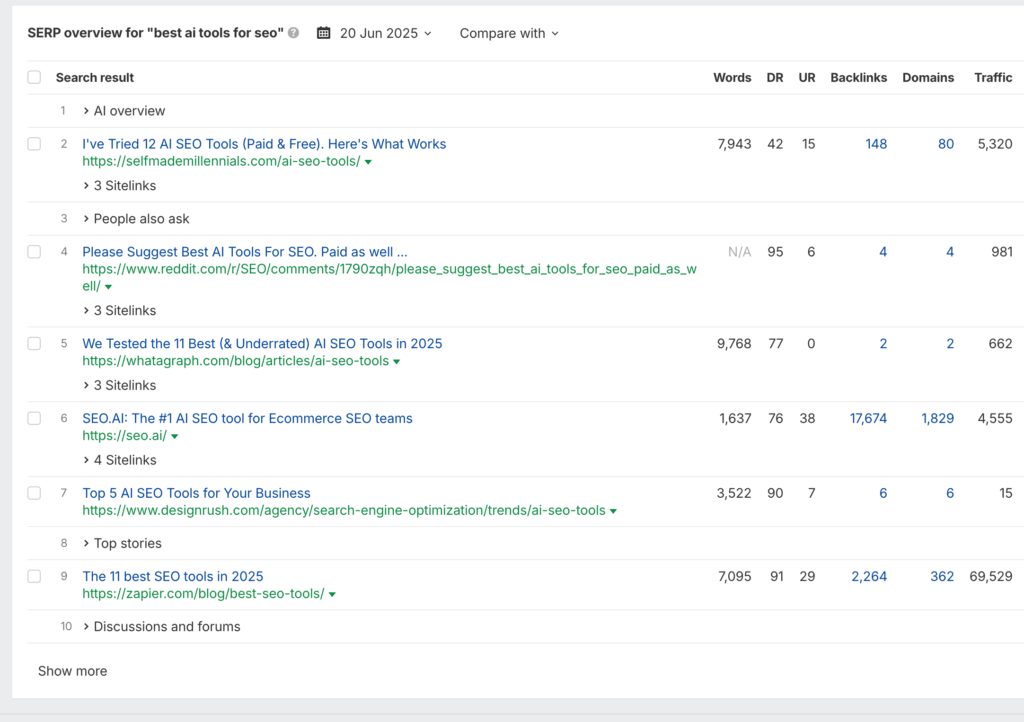Wondering how long a blog post should be for SEO?
Personally, I strive to keep my blogs above 1,200 words. But again, that depends on the topic I’m writing. If I can effectively provide value with 500 words, I’ll do so. That said, such cases are very rare.
I’ve been creating SEO blog content for the past 10 years. Over the decade, I’ve seen changes in the blog post length that authoritative brands publish. For example, in 2018, writing 2,000+ blog posts was common because back then, longer blogs tended to rank higher on Google search.
But does this mean you should always write marathon-length articles? Not necessarily, especially with Google becoming more capable of understanding content.
Still, as a marketer, you need a number to guide your writers, which is understandable.
In this guide, you’ll discover exactly how to determine the perfect length for your blog posts based on data, not guesswork. Let’s dig into what actually works for SEO now.
Ideal Blog Length at a Glance
According to Backlinko, the average blog post length is now over 1,400 words, with first-page Google results averaging 1,500 words.
That’s quite a jump from years past.
Here’s something even more eye-opening: content exceeding 3,000 words generates 138% more page views than articles under 500 words, according to SEMrush. On top of that, longer content also attracts more backlinks. The data clearly shows that, to an extent, blog length matters for SEO.
For example, I published a 1,000+ word review about Smodin. Not only does the article rank on Google, but it also earned a backlink from Smodin, the service provider itself.
Yet, don’t turn SEO content creation into a numbers game. Google has officially stated that word count alone isn’t a ranking factor. In fact, Google’s John Mueller confirmed that “just blindly adding text to a page doesn’t make it better”.
Why Blog Post Length Matters for SEO
Though not a direct ranking factor, longer content helps search engines in crucial ways. When you write comprehensive articles, you give Google’s algorithms more context to understand what your page is about. This improved understanding helps them match your content to relevant searches more effectively.
The link between content depth and keyword coverage
Comprehensive content creates more ranking opportunities. This happens because:
- You cover your primary topic from various angles
- You naturally include more semantic variations of keywords
- You answer more related questions that users might have
Furthermore, SurferSEO found a direct connection between content coverage and visibility.
Articles that thoroughly address a topic (covering 74% of relevant facts) rank for significantly more keywords than those with lower coverage (50%).
As a result, these comprehensive pieces generate more impressions and traffic.
If you need help with keyword research, check out this guide.
Why thin content can hurt your rankings
Since Google’s 2011 Panda algorithm update, the search engine has actively penalized thin content. Think of content as web pages, or blogs that don’t provide users with substantially unique or valuable content.
Signs of thin content include:
- Pages that don’t answer search intent
- Content that lacks depth or original information
- Duplicate or scraped content from other sources
- Pages with unnecessarily low word counts
Remember that Google’s core mission is delivering value to searchers. When your content fails to provide that value, regardless of length, it sends negative signals about your site’s quality.
Factors That Influence Ideal Blog Post Length
The ideal length of your blog post isn’t a one-size-fits-all answer. Instead, several critical factors determine how many words you need to effectively communicate your message while satisfying both readers and search engines.
Understanding search intent
Search intent represents what users are actually looking for when they type a query. This factor significantly impacts how long your content should be.
Different types of search intent require different content lengths:
| Query Type | Example | Content Strategy |
| Informational | How to bake sourdough bread | Comprehensive, in-depth articles that cover the topic thoroughly. |
| Transactional | Best affordable laptops | Shorter, product-focused content that quickly delivers relevant recommendations. |
| Navigational | Facebook login or OpenAI site | Minimal content; users are seeking a specific website, not detailed information. |
To determine the right length, search your target keyword and analyze the top-ranking pages. Check their word count and structure to understand what Google already considers valuable for that particular query.. This approach gives you real-world examples of what works for your specific topic.
Audience knowledge level and expectations
Your target audience’s expertise level directly affects the ideal length of your blog posts. Before writing, ask yourself:
Are you creating content for beginners who need comprehensive background information? Or for experts who want advanced insights without basic explanations?
Audience reading habits also matter.
The University of California research found that young adults (19-32 years) generally have longer attention spans than other age groups.
Nevertheless, today’s readers face countless distractions, so topic relevance matters more than attention span itself.
Another consideration is your readers’ goals. Someone researching deeply before making a purchase decision will likely stay longer with comprehensive content. Consequently, blog posts intended for this audience can be longer.
Industry-specific content norms
Different industries have established content length standards based on topic complexity and audience expectations.
According to studies, content in fields like marketing tends to perform better at lengths over 1,500 words . Meanwhile, lifestyle content often succeeds with briefer posts between 500-800 words that prioritize accessibility.
Technical industries typically demand more detailed explanations. Finance technology (FinTech) content, for instance, often requires thorough coverage due to its complex nature. Similarly, healthcare content frequently needs comprehensive explanations to establish authority and credibility.
How to Determine the Right Length for Your Blog Post
Finding the perfect blog post length doesn’t need to be guesswork. With data-driven approaches, you can determine exactly how long your content should be to satisfy both readers and search engines.
Analyze top-ranking competitors
Begin by examining what already works. Type your target keyword into Google and study the top 10 results. This simple step reveals what content length Google already considers valuable for your specific topic.
If you use Ahrefs, you can view the number of words for each webpage that rank in the SERP. And as you can see, it varies greatly. Again, this points out to the fact that there is no ‘ideal blog length’ for SEO.

So, don’t just count words, but evaluate quality too. Look at:
- How many words do competitors dedicate to each subtopic
- How they develop each idea with appropriate detail
- Their content structure and formatting approaches
Specifically, check how competitors balance depth with readability. If top performers in your niche consistently publish 2,000+ word articles, you’ll likely need similar depth to compete effectively.
Use SEO tools to assess content gaps
Content gap analysis particularly helps identify subtopics your competitors don’t adequately address. When you cover these missing elements, you create more valuable content that naturally reaches the appropriate length without unnecessary padding.
Below are tools that can identify content opportunities your competitors might miss.
- Semrush Content Template analyzes your top 10 organic rivals and provides recommendations, including optimal content length.
- WriteSonic to automatically analyze top-ranking pages and find content opportunities.
- SurferSEO Content Editor for structure suggestions based on top search results
Match length to content type and goal
Different content types naturally require different word counts. Indeed, forcing every article into a single-length template results in either truncated explanations or unnecessary padding.
Consider these general guidelines:
| Content type | Length |
| News articles | 700-1,500 words |
| How-to-guides | 1,500-3,000 words |
| Ultimate guides | 2,500-3,000 words |
| Listicles | 1,000-2,000 words |
Furthermore, align the blog length with your specific goals. For awareness, shorter content often works well. For education, in-depth tutorials naturally require more words. Subsequently, lead generation typically benefits from balanced length, enough information to build trust without overwhelming potential customers.
Focus on value, not just word count
Remember, quality trumps quantity every time. Google’s algorithms prioritize reliable information and pages that demonstrate expertise, authoritativeness, and trustworthiness on a given topic. A well-written 1,000-word article can outperform a 3,000-word piece filled with fluff.
Once, I experimented with publishing dozens of 3,000+ word buyers guides, which don’t offer in-depth value. For a while, they ranked and brought in traffic. Then, Google caught up and promotes content with better value.
So, when creating SEO content, ask yourself:
- Does each paragraph contribute something meaningful?
- Would removing it diminish the article’s value?
- Will you recommend your blog to someone you know?
This approach naturally leads to an appropriate length without fluff.
Conclusion: Aim for quality, not quantity
Throughout this guide, we’ve looked at the data behind blog post length for SEO. The evidence clearly points to longer content, typically between 1,500 and 2,500 words, performing better in search results. However, word count alone won’t guarantee success.
Focus on quality rather than blog length. Don’t let word count limits your blog creation efforts. If you think it takes 3,000 words to truly explain an in-depth guide, go for it. And while you’re at it, always keep your audience in mind.
FAQs
What is the ideal length for a blog post?
While there’s no one-size-fits-all answer, research suggests that blog posts between 1,500 and 2,500 words tend to perform best for SEO. However, the ideal length depends on factors like your topic, audience, and industry norms.
Does longer content always rank better in search results?
Not necessarily. While longer content often performs well, quality is more important than quantity. A well-written, concise post that matches search intent can outrank longer articles filled with unnecessary information.
What’s the relationship between blog post length and backlinks?
Longer, more comprehensive content tends to attract more backlinks. Articles with 3,000+ words receive more backlinks compared with articles with 1,000+ words.
How can I determine the right length for my blog posts?
Analyze top-ranking competitors for your target keywords, use SEO tools to assess content gaps, and match your content length to the specific type and goal of your post. Always prioritize providing value and thoroughly answering user questions over hitting a specific word count.

